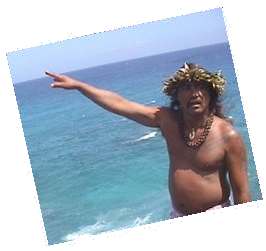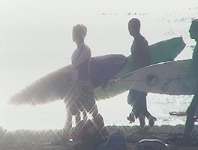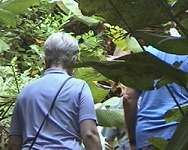
|
The world of non-commercial film and A-V |
Events Diary | Search | ||
| The Film and Video Institute | | ||||
 Michael Gough's Michael Gough'sHawaiian Production Diary THE FILMING PROCESS Location
I won't attempt to describe every thought that passed through my head while
filming but there are a few relevant ones. The first relates to location.
I am trying to capture the essence of a place. In the case of Hawaii it soon
becomes apparent that there are several obvious locations for different
sequences.
It may be that there is too much there for one video. It is sometimes a good idea to make a video around a single day's activity, thus producing 2 or 3 totally different videos from the same holiday. I may eventually produce more than one version from the same material. There may be whole sequences that are shot but disappear for ever in the editing process. It is essential to take shots with a mind on how they might go together as a sequence. What is certain is that a couple of single shots recorded at each location without any thought to their possible future inclusion are probably worthless. Each location/sequence needs a full range of shots, wide-angle (to establish place) through to close-ups to focus on details. There must be a variety of framings which will assist editing by avoiding jump cuts and at the same time will hold the audience's attention. Still shots, panning shots, tracking shots, tilting shots, dramatically framed shots, bustling shots, quiet shots, landscapes and faces etc. The photographer/editor has total control over what the audience sees and how they will react to it (but only if the photographer shot the best material in the first place). So I look around each location wondering what shots are essential to show the subject itself, and what might be useful cutaways to assist the editing. For instance I always take a couple of shots of other people doing their own "looking". They may be applauding, laughing, looking out of the coach window or posing their own photos with the landscape as background. A shot of someone "looking" gives a perfect editorial excuse to show what they are looking at. Locations with random activities
Locations with a fixed viewpoint One day our guide took us to a very high viewing point where we all stopped for the obligatory photo. While filming I didn't know whether I would eventually only use a single shot in a general montage or whether I would produce a short sequence. So I had to film a potential sequence, just in case. You can always edit out shots but you can't add them later if you didn't take them! The trouble is I only had a few yards either side to position the camera. The need then is to look for a variety of differently framed images to avoid the sequence becoming a boring mix of similar shots. So I started with a steady wide angle, then a panning shot (also on wide angle to reduce the camera shake). How about a tilting shot from the peak of the mountain to the left down to the valley below? Then tightly pressing the camera against a wall I tried to steady myself for a long telephoto shot of the headland and sea in the distance. Now for some closeups of other holiday makers peering over the edge, or taking their own photos. I even framed some wider angle shots with the people in the foreground and the magnificent view behind. It is all an exercise in really looking at the location to see how it can be interpreted differently Someone once asked if making a video spoilt my enjoyment of my holiday. It certainly doesn't. It has taught me to look more clearly and thus see more memorably. I think my wife Linda might occasionally disagree! I sometimes think of leaving the camera in the hotel for the day but Hawaii was too tempting. Mobile locations Shots from moving vehicles, particularly slow moving boats provide perfect tracking shots so long as you remember some basic rules. Any telephoto framing will exaggerate any unsteadiness of the camera. Also the effective "blur" of passing objects is increased if they move across the viewfinder quickly. This can be reduced by pointing diagonally forward or backwards rather than directly at right angles out of the side of the boat, particularly if the passing objects are on a nearby bank. I shot some attractive shots in this way from the canoe trip through the Polynesian Cultural Centre. Shooting live music Live musicians can instantly provide local music interludes without the complications of recording copyright. There were many such opportunities in Hawaii. However it is essential to take at least one long continuous shot. Any breaks in the soundtrack as you switch the camera on and off will be much more noticeable than the associated cut in the picture. A long single shot usually looks weak in the final film but it is possible to break it up with appropriate cutaway shots which can be insert edited over the live sound. So I recorded one long music track then took close-ups of musical details such as audience reaction shots, and close-ups of hands playing guitars etc. which did not give away the fact that they were actually playing a different tune. Audiences seldom notice the trick in the editing. Thought and Anticipation In the process of looking for different views of the same thing it is important to think ahead. Sometimes it is more effective to film your subjects before they reach the "key moment" of the shot. For example I saw that in the early evening as people walked into the low sunshine the water behind them started to shimmer with reflected light. This had added effect if they were seen first before they reached the direct line from me to the sun.
Each time you need to think ahead to plan when to maintain a static camera and when to start moving. The same thing applies if the camera movement is a zoom. There is nothing worse than a zoom which is unplanned. The camera zooms in without knowing what the final stationary view will be. Half way the cameraman changes his mind and stops for no purpose or worse still the stop is more like a staggering pause before the zoom starts again. There is also the thought and anticipation that comes from eventually being the editor as well as the photographer. It is possible to think of possible sequences, to recognise which shots that have already been taken might fit and hopefully seek out any extras that will help your eventual plan. I had one shot in mind that I took three times before I was satisfied. I anticipated an edited montage concentrating on surfers in closeup but I wanted a shot that would bring the audience back to the wider beach scene. I was standing on a jetty which stuck out into the Bay. This meant that some surfers on my left passed me so that I seemed to look over them towards the beach and Diamond Head volcano. My intention was to pan left in telephoto concentrating on a group of surfers then at a certain point slow the sideways movement at the same time as zooming gently to wideangle. If all went well I would end up perfectly aligned on the volcano in a final static shot. It was difficult to know exactly when to start the change. All I could see in the viewfinder was a small patch of water with no fixed points of reference. On the first two occasions the deceleration and simultaneous zoom out left me slightly off line with the beach so I had to slightly move the camera again after it had stopped to get the best framing. It looked terrible but eventually I succeeded. It was an interesting challenge with a well considered intention. However at this stage I don't even know if I will keep it in the video. By the way I didn't have a tripod. All my camera work was hand held, though trees and rocks were occasionally used as supports. (A tripod would have been better but I recognise the difficulty of carrying one everywhere on holiday). On this occasion I had to stand up and turn my upper body more than my waistline felt comfortable. I don't find it works to shuffle your feet. You need a good solid base to hold a camera still. Because I knew the final static shot of the beach would have to be held the longest I turned and stood comfortably facing that direction. With my feet firm I then twisted my body back to a less comfortable position for the start of the shot. As well as giving me a good final position it gave me a sense of how my body felt which helped me to know when to start zooming out from the wave. It's strange writing this diary. I can't consciously remember planning all of this. Yet I know it was what I did, and why I did it. After a while the camera becomes part of your body and the viewfinder becomes part of your mind.
|
Share your passions.

Share your stories.
 Waikiki beach is a perfect example of this kind
of location. I walked along it on different days and each time saw people
involved with all sorts of activities. Once you have established the beach
location it is possible to really focus on individuals. They can be cut together
with no fear of jump cuts. That couple strolling arm in arm against the sunset,
that young lad jumping off the jetty, that child eating an icecream, that
girl strumming a ukulele, etc. I try to frame the shot as close as possible
without intruding so that the audience will know exactly what I am trying
to focus their attention on. Each shot will be a single event, the eventual
power will be in their combination with other similar shots.
Waikiki beach is a perfect example of this kind
of location. I walked along it on different days and each time saw people
involved with all sorts of activities. Once you have established the beach
location it is possible to really focus on individuals. They can be cut together
with no fear of jump cuts. That couple strolling arm in arm against the sunset,
that young lad jumping off the jetty, that child eating an icecream, that
girl strumming a ukulele, etc. I try to frame the shot as close as possible
without intruding so that the audience will know exactly what I am trying
to focus their attention on. Each shot will be a single event, the eventual
power will be in their combination with other similar shots.
 The walk through the jungle needed more shots than
the "explorers" continually walking past the camera. Occasionally I ran ahead
and focussed on a leaf and saw them enter the screen from the left. Occasionally
I let them completely leave the screen. Occasionally I panned with a face
or alternatively let a series of people pass across the viewfinder. Once
I hung back as the path twisted ahead of me and saw them from a distance
almost flitting between the vegetation. Once I walked behind with a low slung
camera filming the backs of feet on the path.
The walk through the jungle needed more shots than
the "explorers" continually walking past the camera. Occasionally I ran ahead
and focussed on a leaf and saw them enter the screen from the left. Occasionally
I let them completely leave the screen. Occasionally I panned with a face
or alternatively let a series of people pass across the viewfinder. Once
I hung back as the path twisted ahead of me and saw them from a distance
almost flitting between the vegetation. Once I walked behind with a low slung
camera filming the backs of feet on the path.